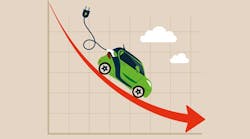Maintenance Mindset: What does the future hold for industrial energy storage and battery manufacturing?
Welcome to Maintenance Mindset, our editors’ takes on things going on in the worlds of manufacturing and asset management that deserve some extra attention. This will appear regularly in the Member’s Only section of the site.
Last week I attended the 2024 Honeywell User Group conference in Dallas to cover key sessions and case studies for a three-day show daily report. In this column I want to highlight a couple sessions for the Plant Services audience about new and expanding industries to support the electrical vehicle market and the pivotal role of root cause analysis for battery cell manufacturers.
Who will be the Google and Amazon of the energy storage market?
Michael Worry, CEO and CTO of Nuvation Energy, compared the energy storage market to the internet in 1995, on the brink of explosion around the turn of the century. Nuvation Energy offers a variety of battery management systems (BMS), including cell interface modules, stack switchgear units, multi-stack controllers and energy management systems (EMS).
In short, his industry outlook was very positive for the energy storage market, citing 90% increase in U.S. battery storage capacity in 2023, a 149% increase in global capacity, and 76% growth in global storage sector investment.
Huge numbers, but they are nearing almost a year old at this point. A lot can happen in a year or less – namely, a stall in the rapidly growing electric vehicle (EV) market. Here’s a quick market outline from the Alliance for Automotive Innovation. The EV market took a quick dip in Q1 of 2024 and then rebounded some in Q2. It continues to expand but not at quite the rate some were predicting.
Vast uncertainty also remains about who the major players in the battery storage market will be over the next decade and even what battery technologies will dominate next after lithium iron phosphate (LFP). Lithium-ion NMC? Sodium-ion, solid-state, lithium sulfur? And there are others in the running.
The speaker compared the top energy storage market players and technologies to some of the internet giants of the early days like AOL and Yahoo, who burned bright quickly and fizzled out. It’s an early stage developing market, and we can make capacity predictions, but the winners and losers of the industry will have to play it out.
U.S. battery cell manufacturers need better data integration
Later in the week, I covered a session with Bill Kephart, senior management consultant at P3, a global consulting agency that supports industrialization in the battery cell market and strategic planning for ramping up cell manufacturing operations. Kephart spent some time outlining the recent slowdown in battery cell demand. In additition to the slumping EV market, he cited supply chain and material cost issues for manufacturers, as well as quality and production issues.
P3 believes that terawatt-hour (TWh) projections of the global market size for batteries by 2030 will be an undersupply of the long-term market, even though currently we have an oversupply. Particularly, in the U.S., government incentives from the Inflation Reduction Act have ramped up new battery cell facilities, but P3 predicts that some—about one-quarter— of that capacity won’t happen.
Also, the battery cell market is dominated by China, who has about a 15-year lead over us on electrification production. Part of the reason for China’s dominance is equipment performance and interoperability.
As a new battery manufacturing facility ramps up operation, it will reach on average an overall equipment effectiveness (OEE) rate between 65 to 70%, with scrap rates around 10%, even after multiple years of operations. Quality issues also plague new battery cell manufacturers, and Kephart blames low OEE rates largely on poor equipment optimization. The lack of software and integration between equipment (often, from many different manufacturers) also poses a key challenge.
In China, by contrast, one company sells entire battery facilities and all the equipment as one package. “This helps the Chinese players a lot in terms of quality and integration,” Kephart said.
Without integrated equipment and software, quality issues will remain. Technical cleanliness is another important hurdle for cell makers, who need to detect and prevent contamination using controlled environments. Like quality standards for battery cell manufacturing, the definition for technical cleanliness still needs some work, Kephart said.
A quality management system (QMS) with clearly defined quality standards integrated with a manufacturing execution system (MES) and traceability software could largely help cell makers, but they’re currently stuck without integrated equipment and software and the data sharing that’s necessary to track back root cause issues to the equipment source and fix the problem and the industry.

